SDSU Football’s State of the Defense
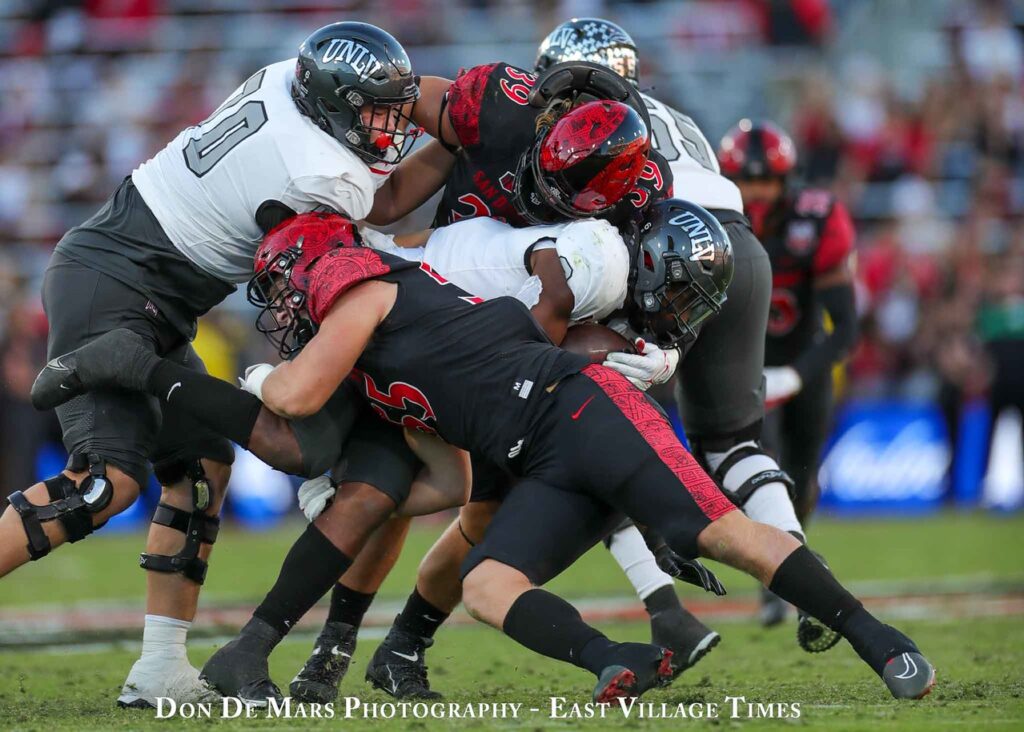
Credit: Don De Mars/ EVT Sports
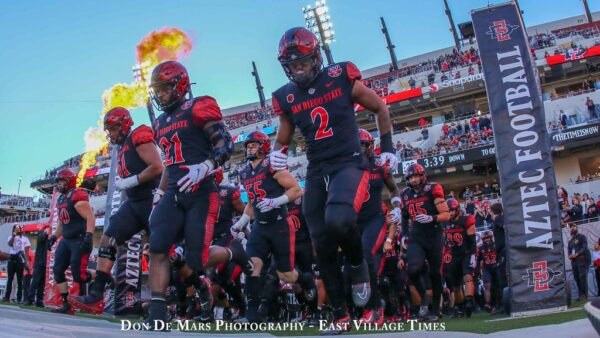
The Aztecs entered 2022 primed to continue their dominant ways under defensive coordinator Kurt Mattix. Despite the loss of Mountain West Defensive Player of the Year and All-American defensive end Cameron Thomas and three other starters to the NFL, seven returning starters, two impact transfers, and a bevy of young players were ready to fill any gaps.
Last year’s defense finished third in FBS in rushing yards allowed per game (80.4), 12th in total defense (324.5), and 17th in scoring defense (19.8). The defense intercepted 17 passes in 2021, fifth best in the country.
While the offensive limitations took the brunt of the criticism for a bumpy 2-3 start this season, the defense did not play up to the high standards set by its predecessors. But over the last four games (SDSU has won three of them), the defense has shown glimpses of returning to its dominant ways.
EVT caught up with defensive coordinator Kurt Mattix after practice on Tuesday. Here are four defensive trends discussed with coach Mattix that are worth monitoring in the final three games of the regular season.
Improved Pressure Since Bye
A large part of SDSU’s defensive success over the past decade in the 3-3-5 scheme has been generating pressure against opposing quarterbacks. Last year’s defense, led by Cameron Thomas’ brilliant season, was 22nd in FBS with 2.93 sacks per game and 48th with 6.14 tackles for loss.
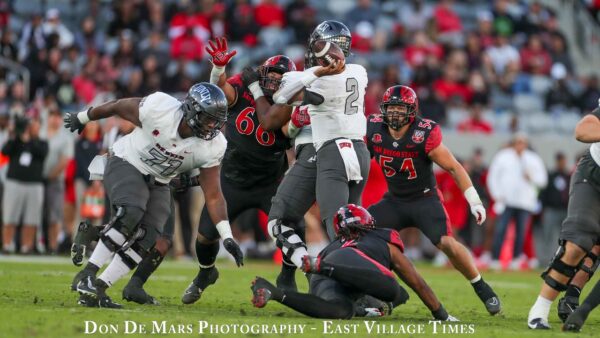
With the return of super seniors Jonah Tavai and Keshawn Banks and the addition of transfer Justus Tavai (Hawai’i), the defensive front was expected to be just as formidable.
Through the first six games, however, the defense’s struggles could be squarely pointed at a disappointing 1.3 sacks and 4.8 tackles for loss per game, 116th, and 101st in FBS, respectively.
The bye week came at an opportune time for SDSU. In the three games since, SDSU is averaging 4.3 sacks and 8.7 tackles for loss per game, boosting its FBS rankings to 52nd and 50th, respectively.
Pro Football Focus (PFF) defines pressures as a combination of sacks, hits, and hurries on the quarterback. SDSU’s pressures have also increased dramatically, from 16.2 to 27.7 per game, since the bye.
The increased pressure has helped the defense allow 80 yards less per game and force eight turnovers after only forcing nine in the first six games.
Mattix believes the improvement is a result of a few factors.
“I think it’s individual players playing better,” he said. “I think if you look at maybe a couple games before versus where we’re at now … Keshawn Banks has really turned it up a notch and has been playing well. Caden McDonald being moved, which is a positional change, (a) personnel change, and then some effective blitzers.”
After zero tackles for loss in the first six games, Banks exploded with 3.5 against Nevada and added 0.5 sacks against UNLV.
Caden McDonald, who was playing middle linebacker for the first six games and moved back to outside linebacker after the bye, collected his first two sacks of the season in the past two games.
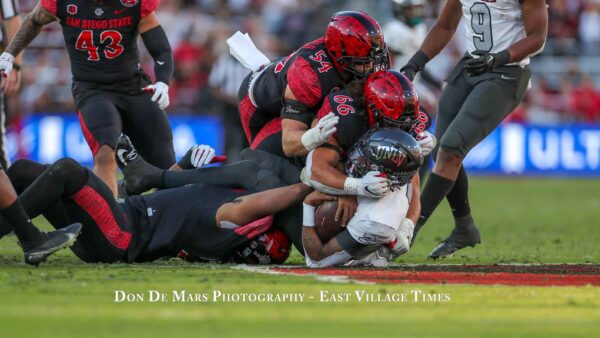
Mattix added that beginning with the Nevada game after the bye; Hoke implemented objective-based goals for each game, such as holding a team under a certain rushing yardage or having a certain number of sacks.
“That was something of a general reminder that at times in the midst of the game, you’re playing well, and you’re keeping them off the board, and then next thing you know, they get a drive. Well, part of that sometimes is the lack of focus that happens in the midst of the game, or maybe a little bit of frustration here or there that happens in the midst of a series. You’re not playing well … or you got beat here. But if you have objective goals, for example, we wanted to have ten tackles for loss against Nevada and then kept bumping it up a little bit each week. Now, after each series, we say hey, we have zero tackles for loss or sacks. Let’s go out and obtain those.”
Six of Michael Shawcroft’s team-leading ten tackles for loss and five of Jonah Tavai’s team-leading six sacks have come in the past three games. Shawcroft also picked up 2.5 sacks in the stretch.
Red Zone Defense
During Episode 33 of The SDSU Football Podcast, Mattix outlined red zone defense as one of the primary areas for improvement from 2021 to 2022. In 2021, the defense allowed scores on 34 of 39 red zone opportunities. That 87.18% rate was 97th in FBS. Twenty-five of those trips ended in touchdowns (64.1%) for the opposing team.
“Last year, we didn’t have very good red zone defense,” said senior linebacker Caden McDonald after the UNLV game. “In the offseason and spring football, we really wanted to focus on that. When (a team is) in the red zone, we want to stop them, hold them to a field goal or to zero points.”
So far, so good in 2022 in aggregate. Through nine games, the Aztecs are 2nd in FBS (behind UCF), allowing 63.33% of red zone trips to end in scores (19 of 30.) 16 of the 30 trips have resulted in touchdowns (53.33%).
“That’s part of our philosophy,” said Mattix. “That’s number three as far as keeping them out of the end zone. And finally, after year three, we feel like we’re making headway. Still not where we want to be but definitely some improvement in that regard.”
The results weren’t always favorable in 2022, though. In SDSU’s first three losses, the opponents scored on all 11 red zone trips, including ten touchdowns. It was not until the Fresno State game two weeks ago that the defense stiffened up in the red zone in a losing effort, allowing only four scores on eight trips.
“I’d say it’s the combination of our staff really understanding what they’re doing a little bit better … and the execution of the (players),” replied Mattix when asked about the reasons for the improvement. “You’re playing similar opponents for the last two or three years. Finally, feel like we as a staff have enough knowledge as far as what opponents are trying to do to us.”
On the 11 trips where SDSU held the other team from scoring, two were a result of missed field goals, four by turnover of downs, one fumble, and four interceptions.
All four interceptions have come in the past two games. According to Mattix, the staff prepares the players in practice by showing them what the opponent is likely to do in red zone situations to give them the confidence to execute on game day.
“To see it come to fruition is a big thing and for us to see our hard work paying off gets the defense pumped up, and I know it gets the offense juiced up too when we hold them,” added McDonald about red zone stops.
[wpedon id=”49075″ align=”right”]
Scoring Defense Discrepancy Between Halves
In the past six games, the Aztecs’ defense has only allowed 17 points in the first half and shut out four of those six opponents. Conversely, the defense allowed 95 points in the second half, a difference of 13 points per half.
Why the drastic change after halftime?
“Our game plans aren’t changing … and the offenses necessarily aren’t doing a couple (different) things,” replied Mattix. “So I don’t think necessarily it’s the calls as much as consistent execution.”
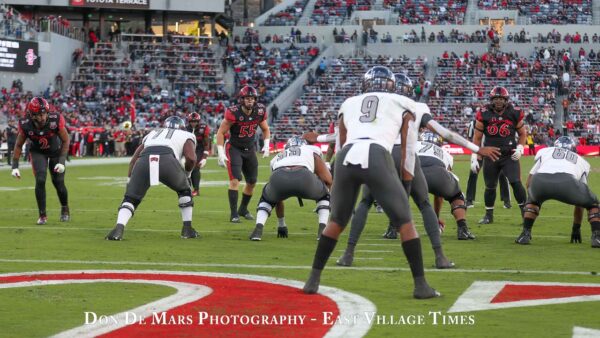
During Tuesday’s press conference, SDSU head coach Brady Hoke attributed this discrepancy to big plays the defense has allowed in the second half.
A 66-yd touchdown catch by Zion Bowens (Hawai’i) and a 70-yd touchdown catch by Nick Williams (UNLV) spoiled shutouts in the third quarter of each of those games.
“If you look at the big play we gave up against UNLV the other day, they hit some speed option,” Mattix noted. “They were getting out on the edge a couple times, and our backside deep half safety sees speed option. He wants to go be a helper on the run and just has bad eyes and bad vision (on that particular play).”
The 35 points allowed to Boise State were the result of a barrage of read-option plays that the defense could not stop the entire second half.
“That was a travesty how we played that game,” Mattix remarked when bringing up the Boise State second half. “It was very disappointing from a coaching standpoint and from an execution standpoint. As a position coach and coordinator, we talk all the time if there is something we could do better.”
The final drives of the Fresno State game drew the ire of fans for dialing back the aggressiveness that the defense had played with in the first 50 minutes that, resulted in seven sacks and continuous harassment of quarterback Jake Haener.
“Sometimes you feel like you have a lead, you might not be as aggressive in some of your play calling, but to me, that’s not necessarily bad because sometimes, if you are a little bit more aggressive, a slip here or slip there and they could go (all the way),” said Mattix.
“But you know, for an overall drive standpoint … you just don’t want the ball thrown over your head. We took off two and a half minutes on that last drive. Probably tighten up a little coverage here and there. There’s always ways that we could do better, I could do better as a play caller, for sure. But I definitely am proud of the way that we’ve been playing the last few weeks, and we got to turn it up a notch.”
Another potential factor assumed for the poor second-half performances was whether the defense was wearing down or fatigued later in games due to playing a lot of snaps. Hoke initially shot down that notion when asked on Tuesday but later acknowledged that the defensive front lost a lot of its experienced depth that helped keep the starters fresher throughout the game.
“You lost four guys who played seven or eight plays a game, but that was taking seven or eight plays a game off of Cam (Thomas), Jonah (Tavai), or Keshawn (Banks),” said Hoke about last season. “We did have more experience and more physically and mentally mature guys that we could go in and out with (last year).”
Two of those players Hoke mentioned, seniors Jalil Lecky and Sefo Mailangi, played 14 and 11 snaps per game last year, respectively.
Cornerback Shuffle
In EVT’s cornerback preview article, four cornerbacks were jockeying for the two starting positions. When asked in fall camp, both Hoke and Mattix preferred set starters in lieu of a rotation at the position.
Noah Avinger and Dallas Branch began the season as starters. By week 3, Avinger was replaced by Dez Malone. By week 4, Branch was replaced by Noah Tumblin. Just this past week, Avinger was back in the starting lineup in place of Tumblin.
“In that defensive back room, we’ve had a little bit of an ebb and flow,” Mattix said. “And this is no disrespect to anybody, but right now, consistently, Dez Malone has been playing really well. Noah Avinger came out of fall camp as a starter and had a little rough go in the first couple games, ended up being a little bit down on the depth chart, and ended up working his way back up to the starter. Noah Tumblin was a starter earlier in the year, not necessarily making as many plays as we think he could make. Moved him down a little bit. That made way for Dallas Branch (who) has been a starter here and there (for us).”
Despite the coaches’ wishes against a rotation at corner, that is essentially how it has played out. Through nine games, the snap counts are as follows:
Dez Malone – 412
Dallas Branch – 274
Noah Avinger – 252
Noah Tumblin – 240
Malone has solidified himself as the top corner. After receiving only 18 snaps in the opening game, he has played at least 47 snaps in every game except Nevada (34). He is one of the best tacklers on the team (33 total tackles), hauled in two interceptions, three pass breakups, and has not allowed a touchdown since week 3 against Utah. He played in 57 of the 61 snaps against UNLV.
His interception in the end zone against UNLV’s Doug Brumfield came in zone coverage.
“(He) went up and made a play at the high point, which whether it’s been out at practice or even on the game field, we’ve been in those positions and haven’t capitalized,” recalled Mattix. “Those are things that make you proud as a coach to see a kid like (Malone) go out and execute and make that play from that standpoint.”
After playing 50 snaps in the opening game of the season against Arizona, Branch’s snap count decreased heavily to the point he was in the teens for three consecutive games. In the past two weeks, Branch was back to 35, and 32 snaps played.
Against UNLV, he put together his best performance as an Aztec earning Mountain West Defensive Player of the Week honors.
Congratulations @Dallasbranch13 for winning Moutain West Defensive Player of the Week. SDSU's cornerback had an interception, a sack, and two tackles for loss in the Aztecs' 14-10 victory over UNLV. pic.twitter.com/D8HzII0ZLQ
— East Village Times (@EVT_News) November 8, 2022
“I’m very proud of Dallas,” said Mattix. “Hats off to a guy that has come in as a Junior College transfer. Really bought into what we’re doing … really love his energy. Love what he’s been able to do, and I think just like anything when you have good competition, you’re continually having to perform at a high level.”
Branch collected four tackles, his first career sack, two tackles for loss, an interception, and a fumble recovery, earning a 90.4 overall grade from PFF. The interception, his first of the season, came when he left his short zone responsibilities and made a play on the ball intended for a receiver streaking behind him in the end zone.
“Last year in the UNLV game, we called the similar coverage in a similar situation, (Branch) was able to take the ball out where this year similar coverage, similar situation, he was able to intercept it,” recalled Mattix.
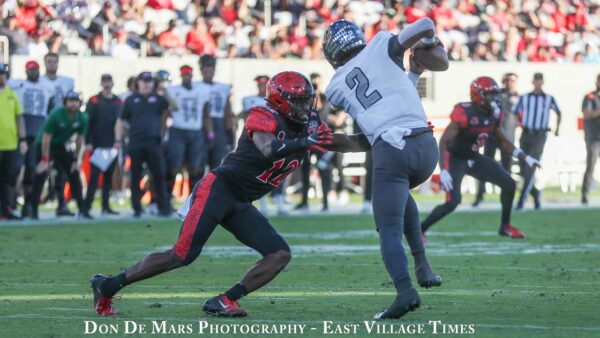
Branch credited the pass rush for forcing Brumfield to throw the ball earlier than he may have wanted to and admitted that once the ball was in the air, he knew he was going to go get it.
“For that coverage, I am just reading the quarterback, going where his eyes take me,” Branch said. “I saw the #1 receiver whip back out into the out route, but I also saw the quarterback looking across the field, and so I decided to sink back and just made a great play on the ball.”
How does a player who went from starter to backup and is unsure when his snaps will come stay ready?
“It starts in practice,” according to Branch. “Taking every snap like you are going to be starting so when your number is called in the game, you are ready to go. Watching film (and) understanding what they want to do offensively and then while the game is going on, watching the other corners in and seeing what they are seeing and what the offense is trying to do so when you go out there, you know what is going on.”
On the season, Branch has 23 tackles, 4.5 tackles for loss, and two pass breakups.
Similar to Branch, Avinger started and played 57 snaps in the opening game against Arizona but has not played more than 39 snaps in a game since. He was back in the starting lineup against UNLV, played well early on but was out-snapped by Branch, 32 to 29. His lone interception on the season came in the end zone against Fresno State’s Jake Haener.
Tumblin, the fourth cornerback in the rotation, played in the first eight games and started the last five of those for the Aztecs. His 16 snaps against Fresno State were the lowest of the season until receiving zero against UNLV. Instead, true freshman Chris Johnson received the four snaps Dez Malone missed in the game.
Avid sports fan and historian of basketball, baseball, football and soccer. UC San Diego and San Diego State alumni living in America’s Finest City. Diverse team following across multiple sports leagues, but Aztecs come first in college athletics.